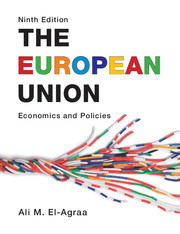Book contents
- Frontmatter
- Contents
- Figures
- Tables
- Boxes
- Contributors
- Preface
- A reader’s guide
- Abbreviations
- 1 General introduction
- Part I EU history, institutions and legal dimension
- Part II EU market integration
- Part III EU monetary integration
- Part IV The single European market
- Part V EU budget and structural policies
- Part VI EU external relations
- Part VII The future of the EU
- Bibliography
- Author Index
- Index
A reader’s guide
- Frontmatter
- Contents
- Figures
- Tables
- Boxes
- Contributors
- Preface
- A reader’s guide
- Abbreviations
- 1 General introduction
- Part I EU history, institutions and legal dimension
- Part II EU market integration
- Part III EU monetary integration
- Part IV The single European market
- Part V EU budget and structural policies
- Part VI EU external relations
- Part VII The future of the EU
- Bibliography
- Author Index
- Index
Summary
A reader’s guide
The book is written in such a way that pure theory and measurement techniques are confined to separate chapters. This means that the policy chapters should be accessible to all readers. However, it also means that those who seek a rigorous, yet brief, background on international economic integration can find it handily in the same book. Moreover, as my contributors will no doubt attest, my editing style has been to ensure that the book reads as a whole, not as a collection of independent articles, each contributed for its own sake. This has been ensured through thorough editing and consultation with the contributors, cross-referencing, allowing repetition only where absolutely necessary, logical sequencing and a setting which begins with an introductory chapter and finishes with one on the future of the EU. In the process, I have tried my best not to distract from any contributor’s own writing style. Therefore the reader has a unique product which offers a truly single entity, yet is authored by several acknowledged authorities in the various fields.
As to the reader’s guide, for those truly interested in the EU as a whole, you will of course have to read the entire book, if you really want to understand it as a most successful scheme of international economic integration, with aspirations going beyond that. However, those who are simply interested in the EU itself without the global context can skip Chapters 6, 9 and 10, since these are devoted to theoretical and measurement considerations which pertain to all schemes. Those interested only in the EU policy areas can drop Chapters 2–6 and 9, although Chapter 2 is important for a proper understanding. Those interested only in the EU economic policies can drop Chapters 2–4 and 23 and, if not interested in the future of the EU, can also drop Chapter 26. Those interested only in EMU and the euro can confine themselves to Chapters 7, 8 and 10–12, but are advised to read Chapters 2 and 26 for a proper understanding; those interested in this area with an emphasis on the UK will find my book The Euro and Britain: Implications of Moving into EMU (2002) more appropriate. Also various combinations of chapters can be made, depending on what the user/reader has in mind – for example, those interested in a very basic understanding of the EU can use Chapters 2, 3, 5 and 26.
- Type
- Chapter
- Information
- The European UnionEconomics and Policies, pp. xxPublisher: Cambridge University PressPrint publication year: 2011



